BSc Nursing: ANAT 1106 - Anatomy, Physiology, and Pharmacology
VerifiedAdded on 2023/06/18
|67
|7770
|269
Homework Assignment
AI Summary
This assignment covers fundamental concepts in anatomy, physiology, and pharmacology, including cell structure and function, homeostasis mechanisms, the reproductive system, and genetics. It features diagrams, multiple-choice questions, and short answer questions designed to test understanding of key topics such as cell organelles, tissue types, feedback mechanisms, reproductive system components, and genetic inheritance patterns. The content is relevant for students in BSc Nursing programs and provides a comprehensive review of essential biological principles. Desklib offers a platform for students to access and utilize such solved assignments and study resources.
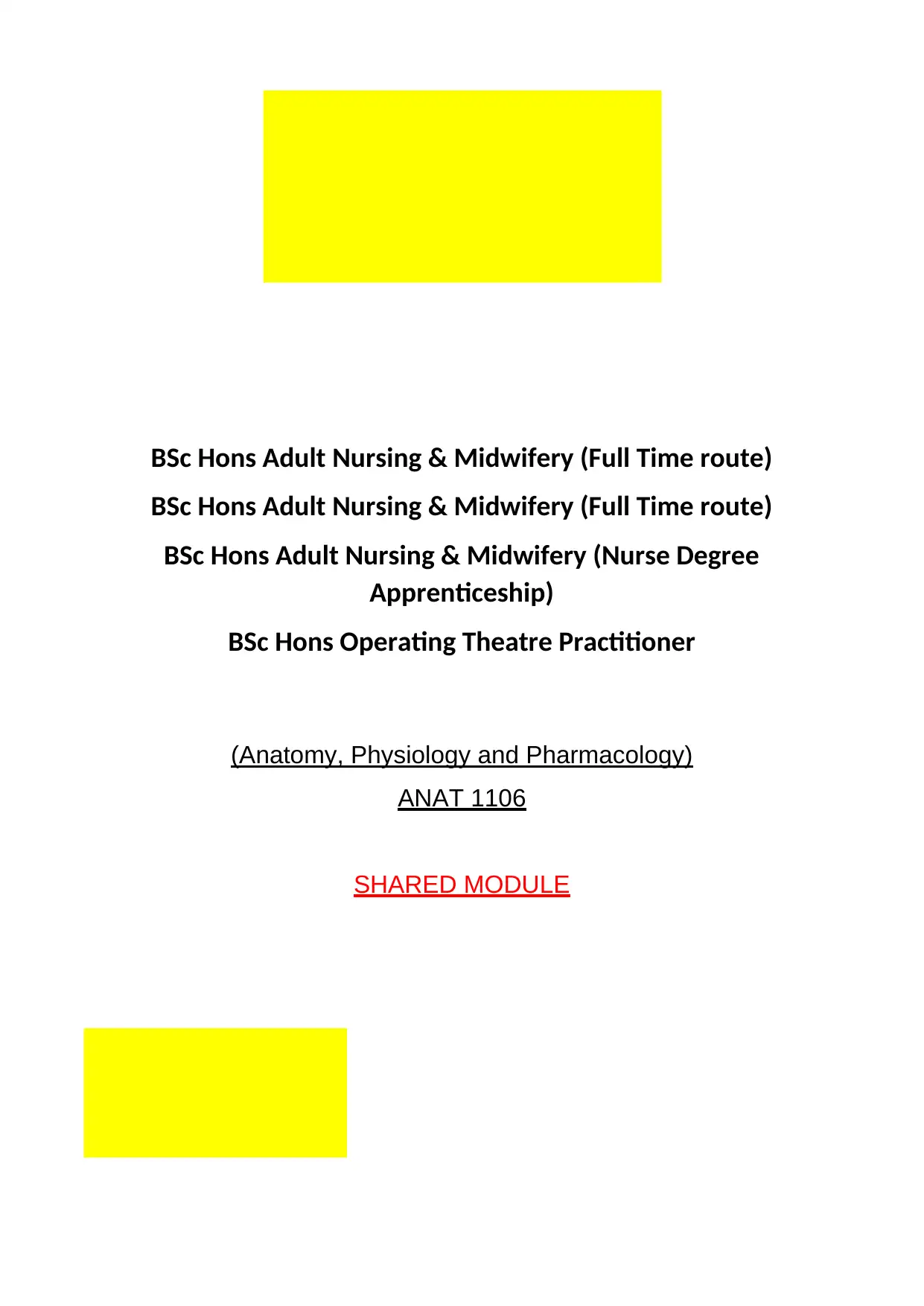
BSc Hons Adult Nursing & Midwifery (Full Time route)
BSc Hons Adult Nursing & Midwifery (Full Time route)
BSc Hons Adult Nursing & Midwifery (Nurse Degree
Apprenticeship)
BSc Hons Operating Theatre Practitioner
(Anatomy, Physiology and Pharmacology)
ANAT 1106
SHARED MODULE
BSc Hons Adult Nursing & Midwifery (Full Time route)
BSc Hons Adult Nursing & Midwifery (Nurse Degree
Apprenticeship)
BSc Hons Operating Theatre Practitioner
(Anatomy, Physiology and Pharmacology)
ANAT 1106
SHARED MODULE
Paraphrase This Document
Need a fresh take? Get an instant paraphrase of this document with our AI Paraphraser
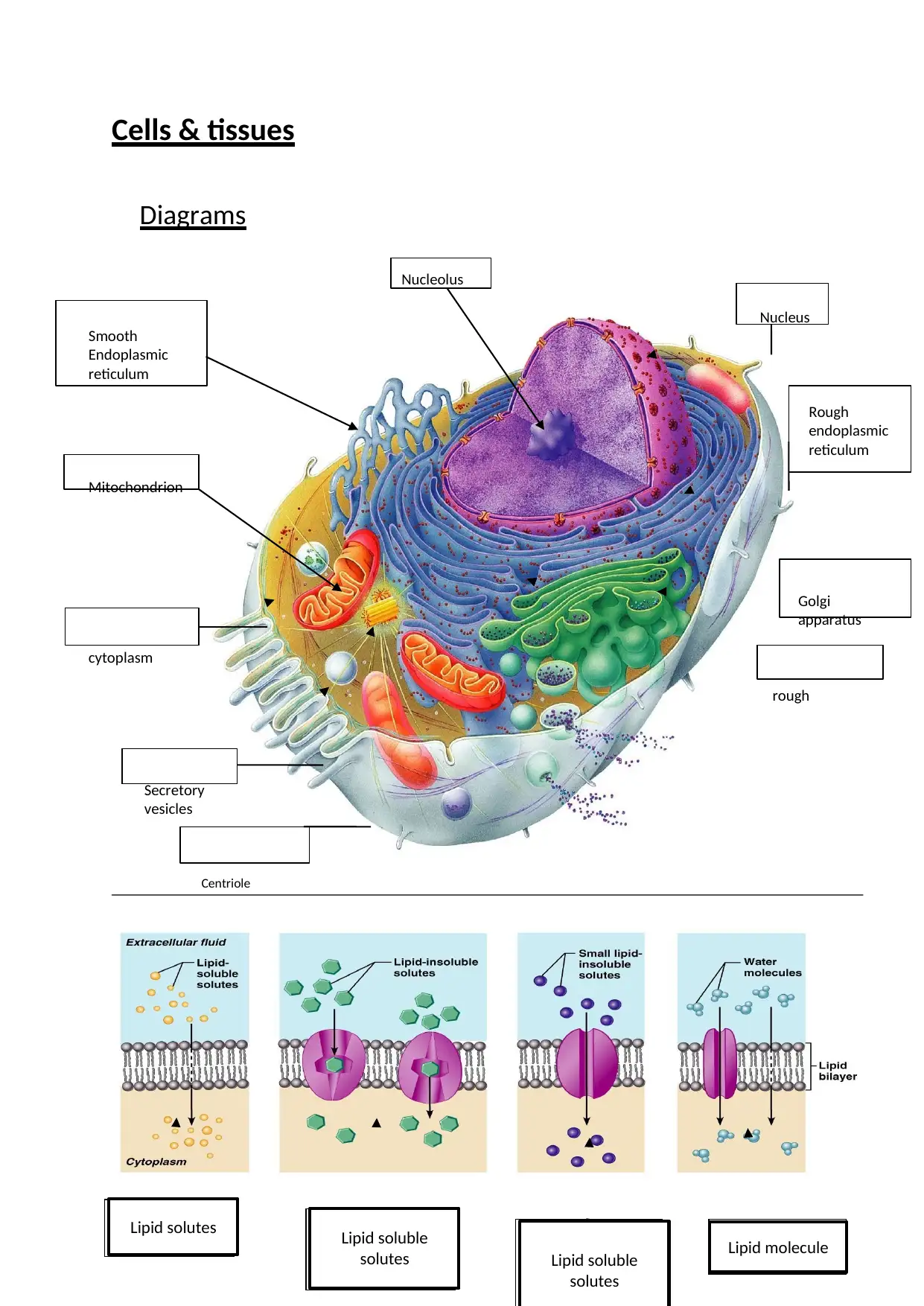
Cells & tissues
Diagrams
Nucleolus
Nucleus
Smooth
Endoplasmic
reticulum
Rough
endoplasmic
reticulum
Mitochondrion
Golgi
apparatus
cytoplasm
rough
Secretory
vesicles
Centriole
Lipid solutes Lipid soluble
solutes Lipid soluble
solutes
Lipid molecule
Diagrams
Nucleolus
Nucleus
Smooth
Endoplasmic
reticulum
Rough
endoplasmic
reticulum
Mitochondrion
Golgi
apparatus
cytoplasm
rough
Secretory
vesicles
Centriole
Lipid solutes Lipid soluble
solutes Lipid soluble
solutes
Lipid molecule
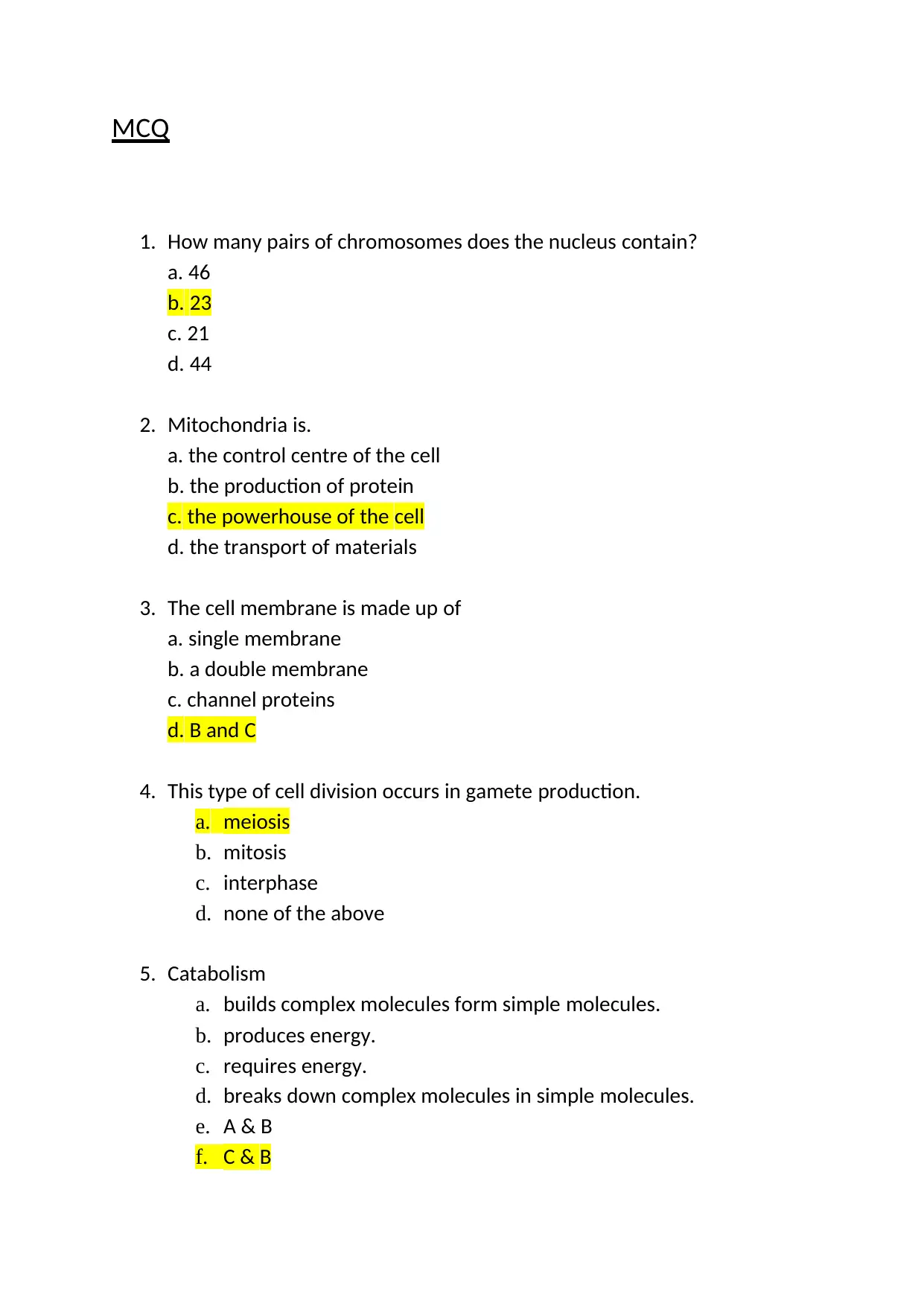
MCQ
1. How many pairs of chromosomes does the nucleus contain?
a. 46
b. 23
c. 21
d. 44
2. Mitochondria is.
a. the control centre of the cell
b. the production of protein
c. the powerhouse of the cell
d. the transport of materials
3. The cell membrane is made up of
a. single membrane
b. a double membrane
c. channel proteins
d. B and C
4. This type of cell division occurs in gamete production.
a. meiosis
b. mitosis
c. interphase
d. none of the above
5. Catabolism
a. builds complex molecules form simple molecules.
b. produces energy.
c. requires energy.
d. breaks down complex molecules in simple molecules.
e. A & B
f. C & B
1. How many pairs of chromosomes does the nucleus contain?
a. 46
b. 23
c. 21
d. 44
2. Mitochondria is.
a. the control centre of the cell
b. the production of protein
c. the powerhouse of the cell
d. the transport of materials
3. The cell membrane is made up of
a. single membrane
b. a double membrane
c. channel proteins
d. B and C
4. This type of cell division occurs in gamete production.
a. meiosis
b. mitosis
c. interphase
d. none of the above
5. Catabolism
a. builds complex molecules form simple molecules.
b. produces energy.
c. requires energy.
d. breaks down complex molecules in simple molecules.
e. A & B
f. C & B
⊘ This is a preview!⊘
Do you want full access?
Subscribe today to unlock all pages.

Trusted by 1+ million students worldwide
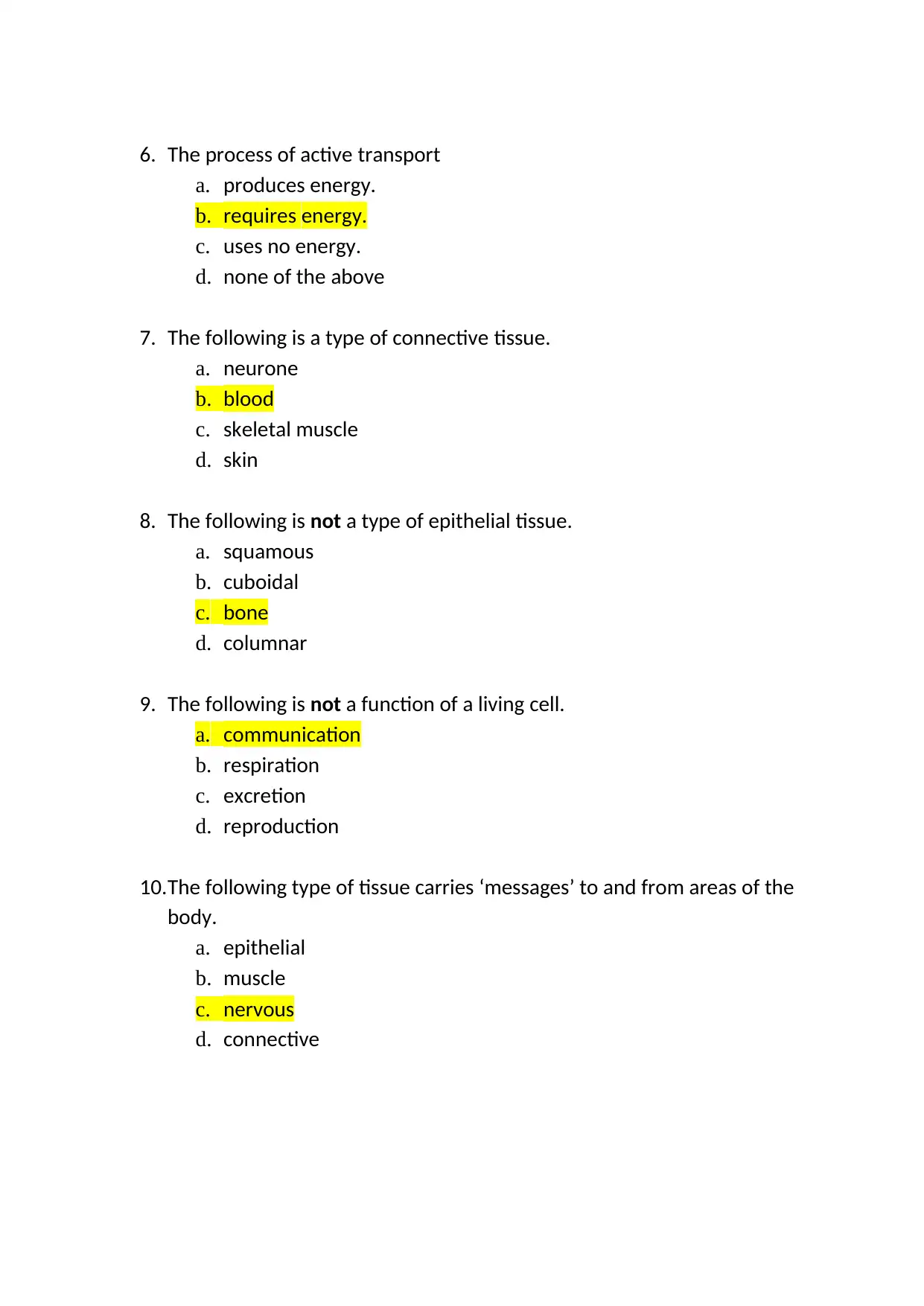
6. The process of active transport
a. produces energy.
b. requires energy.
c. uses no energy.
d. none of the above
7. The following is a type of connective tissue.
a. neurone
b. blood
c. skeletal muscle
d. skin
8. The following is not a type of epithelial tissue.
a. squamous
b. cuboidal
c. bone
d. columnar
9. The following is not a function of a living cell.
a. communication
b. respiration
c. excretion
d. reproduction
10.The following type of tissue carries ‘messages’ to and from areas of the
body.
a. epithelial
b. muscle
c. nervous
d. connective
a. produces energy.
b. requires energy.
c. uses no energy.
d. none of the above
7. The following is a type of connective tissue.
a. neurone
b. blood
c. skeletal muscle
d. skin
8. The following is not a type of epithelial tissue.
a. squamous
b. cuboidal
c. bone
d. columnar
9. The following is not a function of a living cell.
a. communication
b. respiration
c. excretion
d. reproduction
10.The following type of tissue carries ‘messages’ to and from areas of the
body.
a. epithelial
b. muscle
c. nervous
d. connective
Paraphrase This Document
Need a fresh take? Get an instant paraphrase of this document with our AI Paraphraser
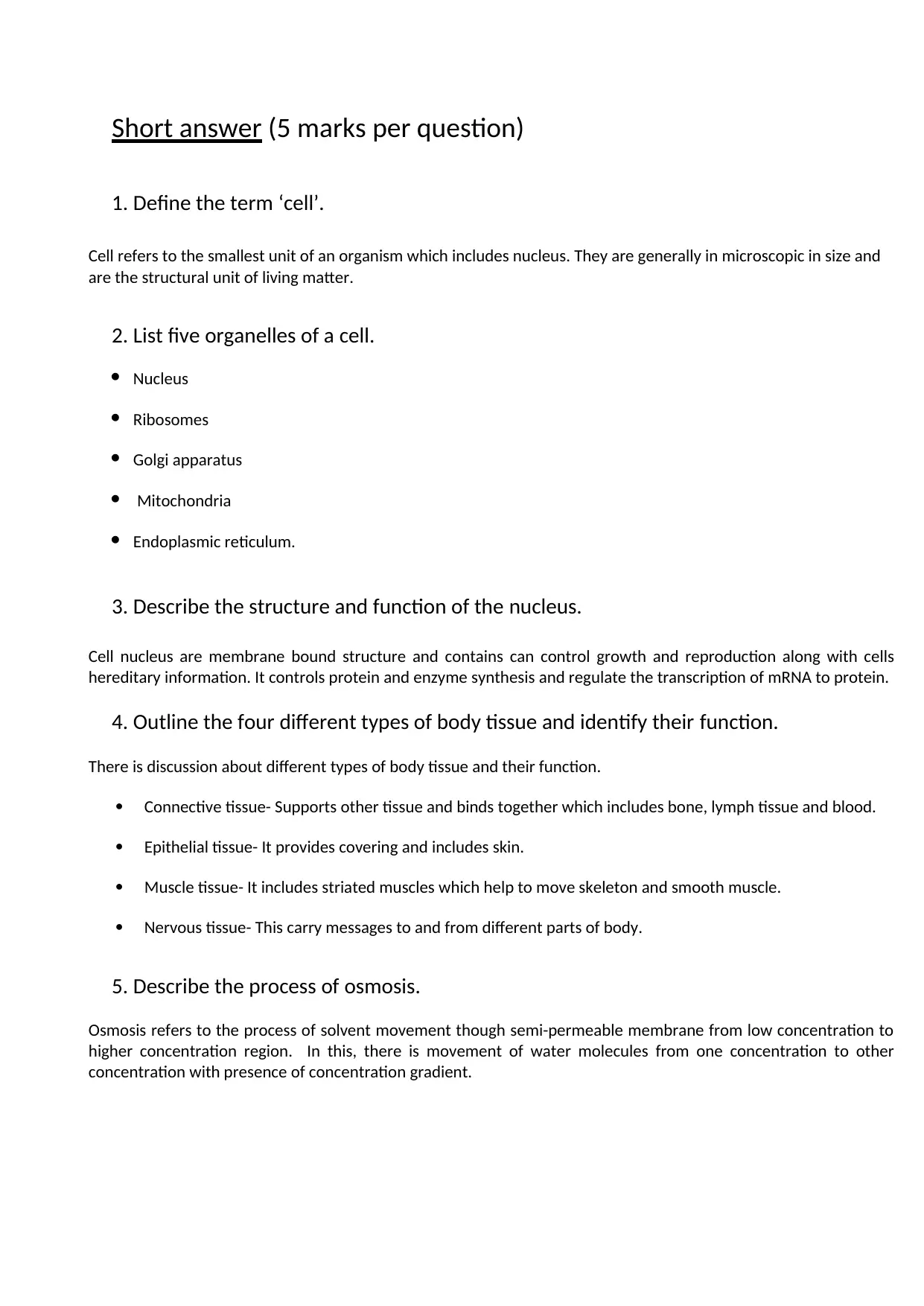
Short answer (5 marks per question)
1. Define the term ‘cell’.
Cell refers to the smallest unit of an organism which includes nucleus. They are generally in microscopic in size and
are the structural unit of living matter.
2. List five organelles of a cell.
Nucleus
Ribosomes
Golgi apparatus
Mitochondria
Endoplasmic reticulum.
3. Describe the structure and function of the nucleus.
Cell nucleus are membrane bound structure and contains can control growth and reproduction along with cells
hereditary information. It controls protein and enzyme synthesis and regulate the transcription of mRNA to protein.
4. Outline the four different types of body tissue and identify their function.
There is discussion about different types of body tissue and their function.
Connective tissue- Supports other tissue and binds together which includes bone, lymph tissue and blood.
Epithelial tissue- It provides covering and includes skin.
Muscle tissue- It includes striated muscles which help to move skeleton and smooth muscle.
Nervous tissue- This carry messages to and from different parts of body.
5. Describe the process of osmosis.
Osmosis refers to the process of solvent movement though semi-permeable membrane from low concentration to
higher concentration region. In this, there is movement of water molecules from one concentration to other
concentration with presence of concentration gradient.
1. Define the term ‘cell’.
Cell refers to the smallest unit of an organism which includes nucleus. They are generally in microscopic in size and
are the structural unit of living matter.
2. List five organelles of a cell.
Nucleus
Ribosomes
Golgi apparatus
Mitochondria
Endoplasmic reticulum.
3. Describe the structure and function of the nucleus.
Cell nucleus are membrane bound structure and contains can control growth and reproduction along with cells
hereditary information. It controls protein and enzyme synthesis and regulate the transcription of mRNA to protein.
4. Outline the four different types of body tissue and identify their function.
There is discussion about different types of body tissue and their function.
Connective tissue- Supports other tissue and binds together which includes bone, lymph tissue and blood.
Epithelial tissue- It provides covering and includes skin.
Muscle tissue- It includes striated muscles which help to move skeleton and smooth muscle.
Nervous tissue- This carry messages to and from different parts of body.
5. Describe the process of osmosis.
Osmosis refers to the process of solvent movement though semi-permeable membrane from low concentration to
higher concentration region. In this, there is movement of water molecules from one concentration to other
concentration with presence of concentration gradient.
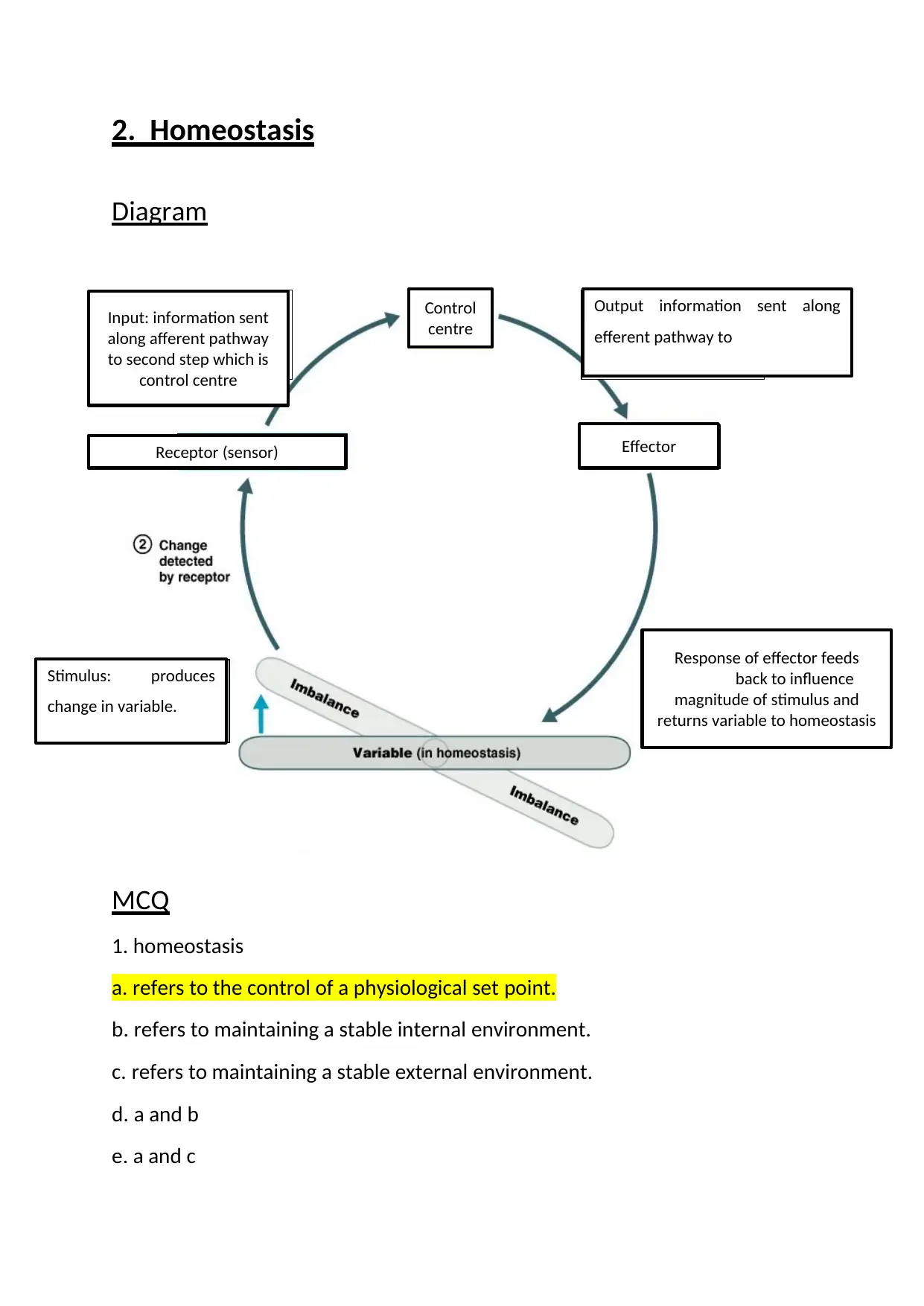
2. Homeostasis
Diagram
MCQ
1. homeostasis
a. refers to the control of a physiological set point.
b. refers to maintaining a stable internal environment.
c. refers to maintaining a stable external environment.
d. a and b
e. a and c
Input: information sent
along afferent pathway
to second step which is
control centre
Receptor (sensor)
Stimulus: produces
change in variable.
Control
centre
Output information sent along
efferent pathway to
Effector
Response of effector feeds
back to influence
magnitude of stimulus and
returns variable to homeostasis
Diagram
MCQ
1. homeostasis
a. refers to the control of a physiological set point.
b. refers to maintaining a stable internal environment.
c. refers to maintaining a stable external environment.
d. a and b
e. a and c
Input: information sent
along afferent pathway
to second step which is
control centre
Receptor (sensor)
Stimulus: produces
change in variable.
Control
centre
Output information sent along
efferent pathway to
Effector
Response of effector feeds
back to influence
magnitude of stimulus and
returns variable to homeostasis
⊘ This is a preview!⊘
Do you want full access?
Subscribe today to unlock all pages.

Trusted by 1+ million students worldwide
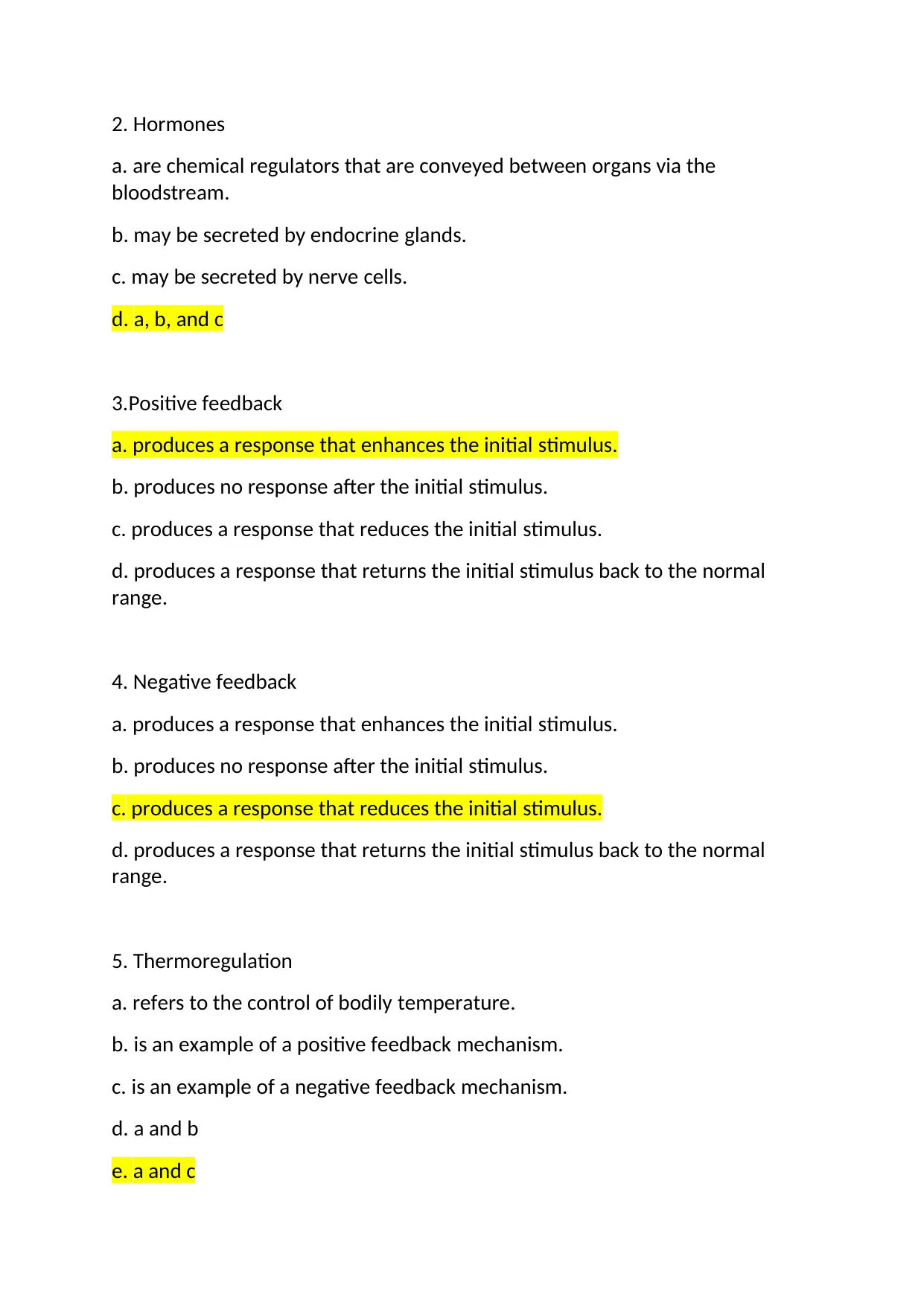
2. Hormones
a. are chemical regulators that are conveyed between organs via the
bloodstream.
b. may be secreted by endocrine glands.
c. may be secreted by nerve cells.
d. a, b, and c
3.Positive feedback
a. produces a response that enhances the initial stimulus.
b. produces no response after the initial stimulus.
c. produces a response that reduces the initial stimulus.
d. produces a response that returns the initial stimulus back to the normal
range.
4. Negative feedback
a. produces a response that enhances the initial stimulus.
b. produces no response after the initial stimulus.
c. produces a response that reduces the initial stimulus.
d. produces a response that returns the initial stimulus back to the normal
range.
5. Thermoregulation
a. refers to the control of bodily temperature.
b. is an example of a positive feedback mechanism.
c. is an example of a negative feedback mechanism.
d. a and b
e. a and c
a. are chemical regulators that are conveyed between organs via the
bloodstream.
b. may be secreted by endocrine glands.
c. may be secreted by nerve cells.
d. a, b, and c
3.Positive feedback
a. produces a response that enhances the initial stimulus.
b. produces no response after the initial stimulus.
c. produces a response that reduces the initial stimulus.
d. produces a response that returns the initial stimulus back to the normal
range.
4. Negative feedback
a. produces a response that enhances the initial stimulus.
b. produces no response after the initial stimulus.
c. produces a response that reduces the initial stimulus.
d. produces a response that returns the initial stimulus back to the normal
range.
5. Thermoregulation
a. refers to the control of bodily temperature.
b. is an example of a positive feedback mechanism.
c. is an example of a negative feedback mechanism.
d. a and b
e. a and c
Paraphrase This Document
Need a fresh take? Get an instant paraphrase of this document with our AI Paraphraser
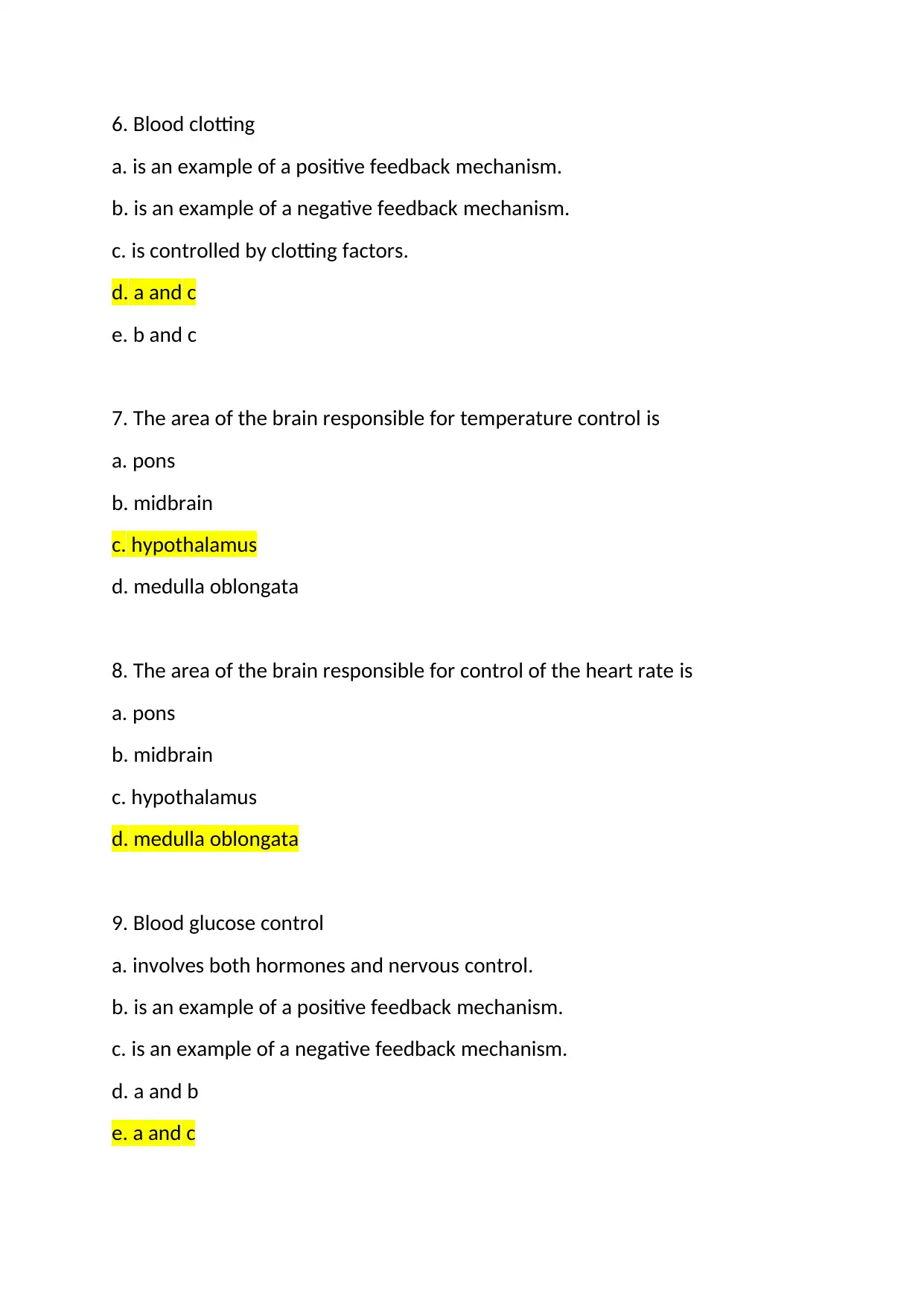
6. Blood clotting
a. is an example of a positive feedback mechanism.
b. is an example of a negative feedback mechanism.
c. is controlled by clotting factors.
d. a and c
e. b and c
7. The area of the brain responsible for temperature control is
a. pons
b. midbrain
c. hypothalamus
d. medulla oblongata
8. The area of the brain responsible for control of the heart rate is
a. pons
b. midbrain
c. hypothalamus
d. medulla oblongata
9. Blood glucose control
a. involves both hormones and nervous control.
b. is an example of a positive feedback mechanism.
c. is an example of a negative feedback mechanism.
d. a and b
e. a and c
a. is an example of a positive feedback mechanism.
b. is an example of a negative feedback mechanism.
c. is controlled by clotting factors.
d. a and c
e. b and c
7. The area of the brain responsible for temperature control is
a. pons
b. midbrain
c. hypothalamus
d. medulla oblongata
8. The area of the brain responsible for control of the heart rate is
a. pons
b. midbrain
c. hypothalamus
d. medulla oblongata
9. Blood glucose control
a. involves both hormones and nervous control.
b. is an example of a positive feedback mechanism.
c. is an example of a negative feedback mechanism.
d. a and b
e. a and c
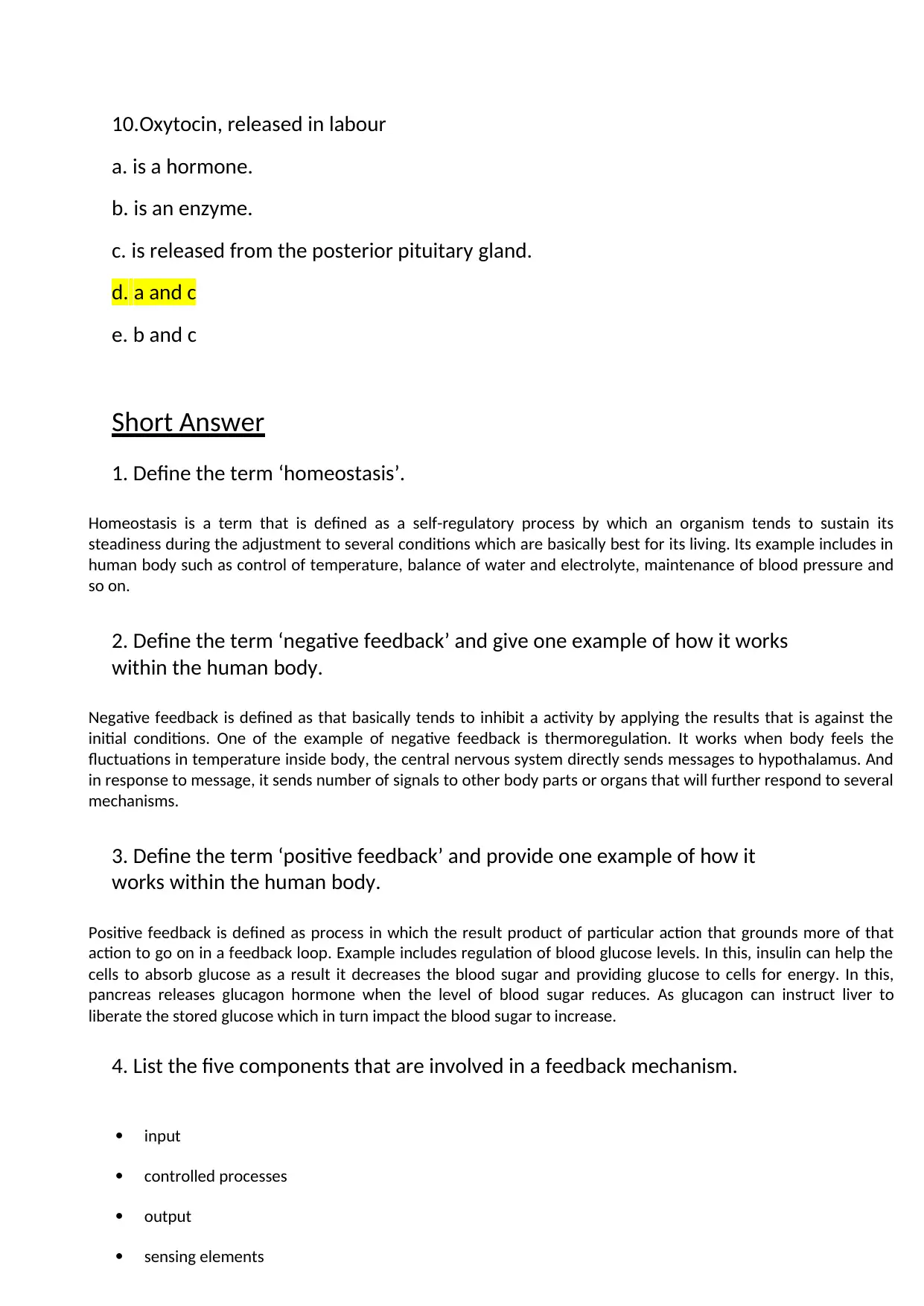
10.Oxytocin, released in labour
a. is a hormone.
b. is an enzyme.
c. is released from the posterior pituitary gland.
d. a and c
e. b and c
Short Answer
1. Define the term ‘homeostasis’.
Homeostasis is a term that is defined as a self-regulatory process by which an organism tends to sustain its
steadiness during the adjustment to several conditions which are basically best for its living. Its example includes in
human body such as control of temperature, balance of water and electrolyte, maintenance of blood pressure and
so on.
2. Define the term ‘negative feedback’ and give one example of how it works
within the human body.
Negative feedback is defined as that basically tends to inhibit a activity by applying the results that is against the
initial conditions. One of the example of negative feedback is thermoregulation. It works when body feels the
fluctuations in temperature inside body, the central nervous system directly sends messages to hypothalamus. And
in response to message, it sends number of signals to other body parts or organs that will further respond to several
mechanisms.
3. Define the term ‘positive feedback’ and provide one example of how it
works within the human body.
Positive feedback is defined as process in which the result product of particular action that grounds more of that
action to go on in a feedback loop. Example includes regulation of blood glucose levels. In this, insulin can help the
cells to absorb glucose as a result it decreases the blood sugar and providing glucose to cells for energy. In this,
pancreas releases glucagon hormone when the level of blood sugar reduces. As glucagon can instruct liver to
liberate the stored glucose which in turn impact the blood sugar to increase.
4. List the five components that are involved in a feedback mechanism.
input
controlled processes
output
sensing elements
a. is a hormone.
b. is an enzyme.
c. is released from the posterior pituitary gland.
d. a and c
e. b and c
Short Answer
1. Define the term ‘homeostasis’.
Homeostasis is a term that is defined as a self-regulatory process by which an organism tends to sustain its
steadiness during the adjustment to several conditions which are basically best for its living. Its example includes in
human body such as control of temperature, balance of water and electrolyte, maintenance of blood pressure and
so on.
2. Define the term ‘negative feedback’ and give one example of how it works
within the human body.
Negative feedback is defined as that basically tends to inhibit a activity by applying the results that is against the
initial conditions. One of the example of negative feedback is thermoregulation. It works when body feels the
fluctuations in temperature inside body, the central nervous system directly sends messages to hypothalamus. And
in response to message, it sends number of signals to other body parts or organs that will further respond to several
mechanisms.
3. Define the term ‘positive feedback’ and provide one example of how it
works within the human body.
Positive feedback is defined as process in which the result product of particular action that grounds more of that
action to go on in a feedback loop. Example includes regulation of blood glucose levels. In this, insulin can help the
cells to absorb glucose as a result it decreases the blood sugar and providing glucose to cells for energy. In this,
pancreas releases glucagon hormone when the level of blood sugar reduces. As glucagon can instruct liver to
liberate the stored glucose which in turn impact the blood sugar to increase.
4. List the five components that are involved in a feedback mechanism.
input
controlled processes
output
sensing elements
⊘ This is a preview!⊘
Do you want full access?
Subscribe today to unlock all pages.

Trusted by 1+ million students worldwide
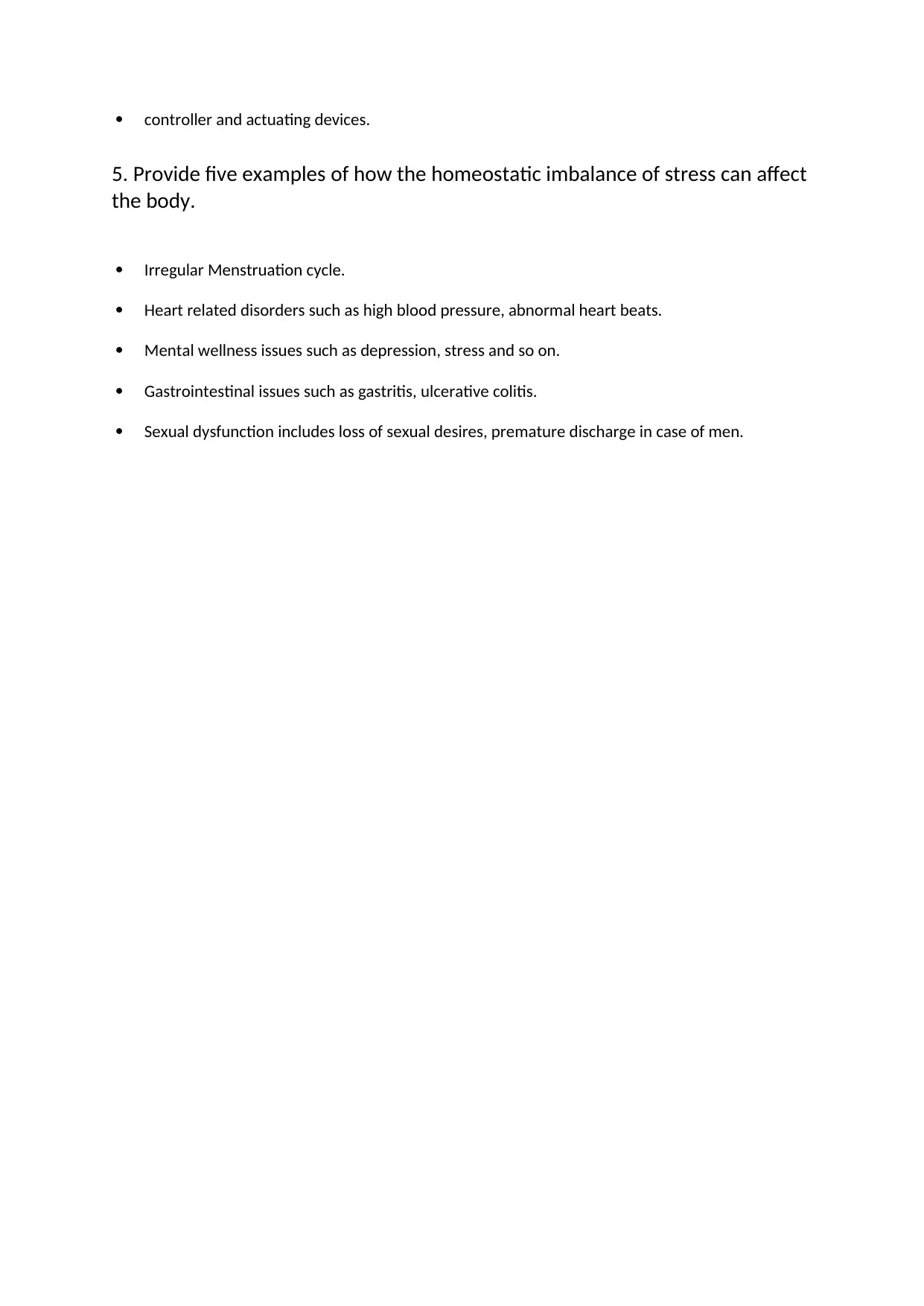
controller and actuating devices.
5. Provide five examples of how the homeostatic imbalance of stress can affect
the body.
Irregular Menstruation cycle.
Heart related disorders such as high blood pressure, abnormal heart beats.
Mental wellness issues such as depression, stress and so on.
Gastrointestinal issues such as gastritis, ulcerative colitis.
Sexual dysfunction includes loss of sexual desires, premature discharge in case of men.
5. Provide five examples of how the homeostatic imbalance of stress can affect
the body.
Irregular Menstruation cycle.
Heart related disorders such as high blood pressure, abnormal heart beats.
Mental wellness issues such as depression, stress and so on.
Gastrointestinal issues such as gastritis, ulcerative colitis.
Sexual dysfunction includes loss of sexual desires, premature discharge in case of men.
Paraphrase This Document
Need a fresh take? Get an instant paraphrase of this document with our AI Paraphraser
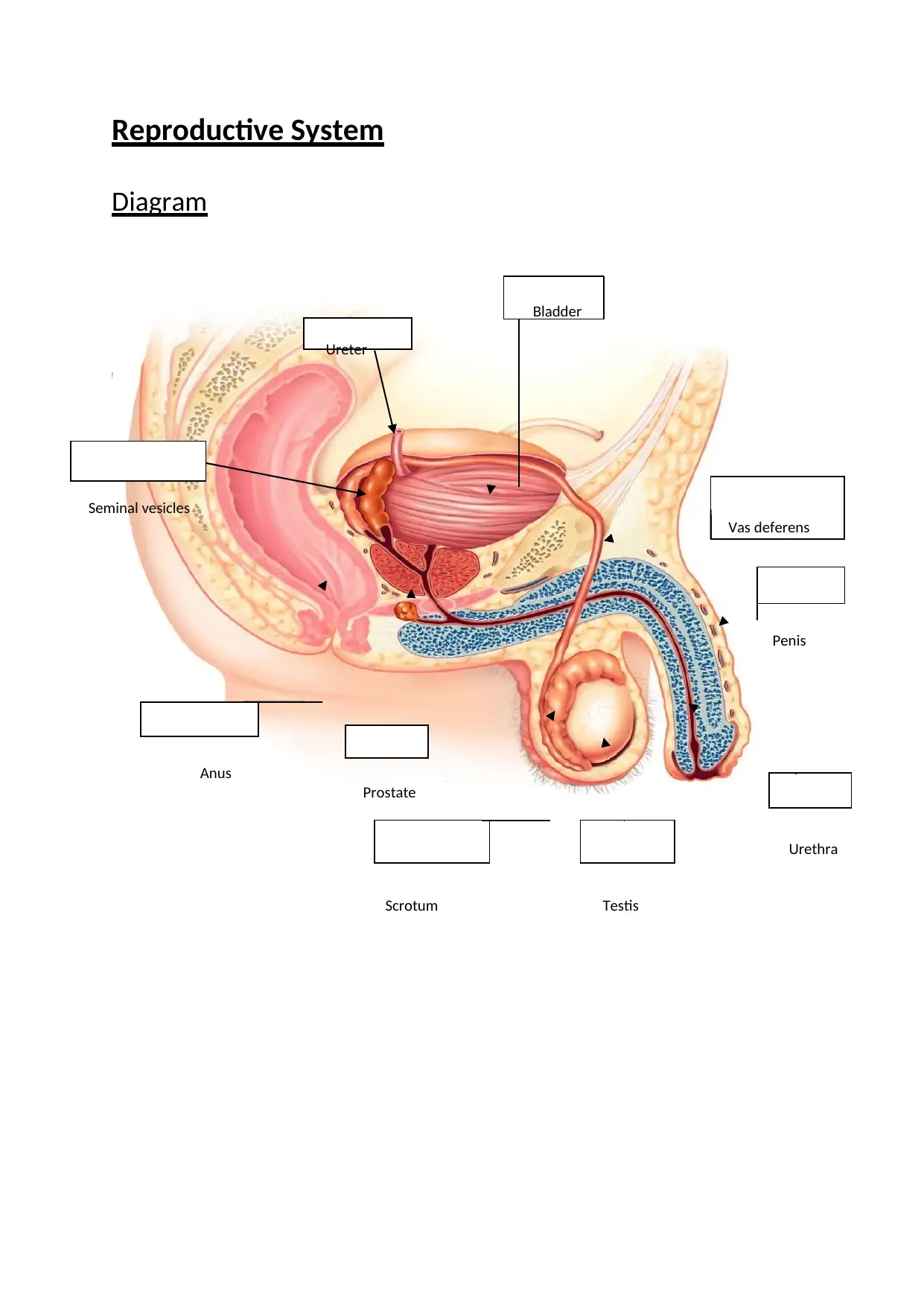
Reproductive System
Diagram
Bladder
Ureter
Seminal vesicles
Vas deferens
Penis
Anus
Prostate
Urethra
Scrotum Testis
Diagram
Bladder
Ureter
Seminal vesicles
Vas deferens
Penis
Anus
Prostate
Urethra
Scrotum Testis
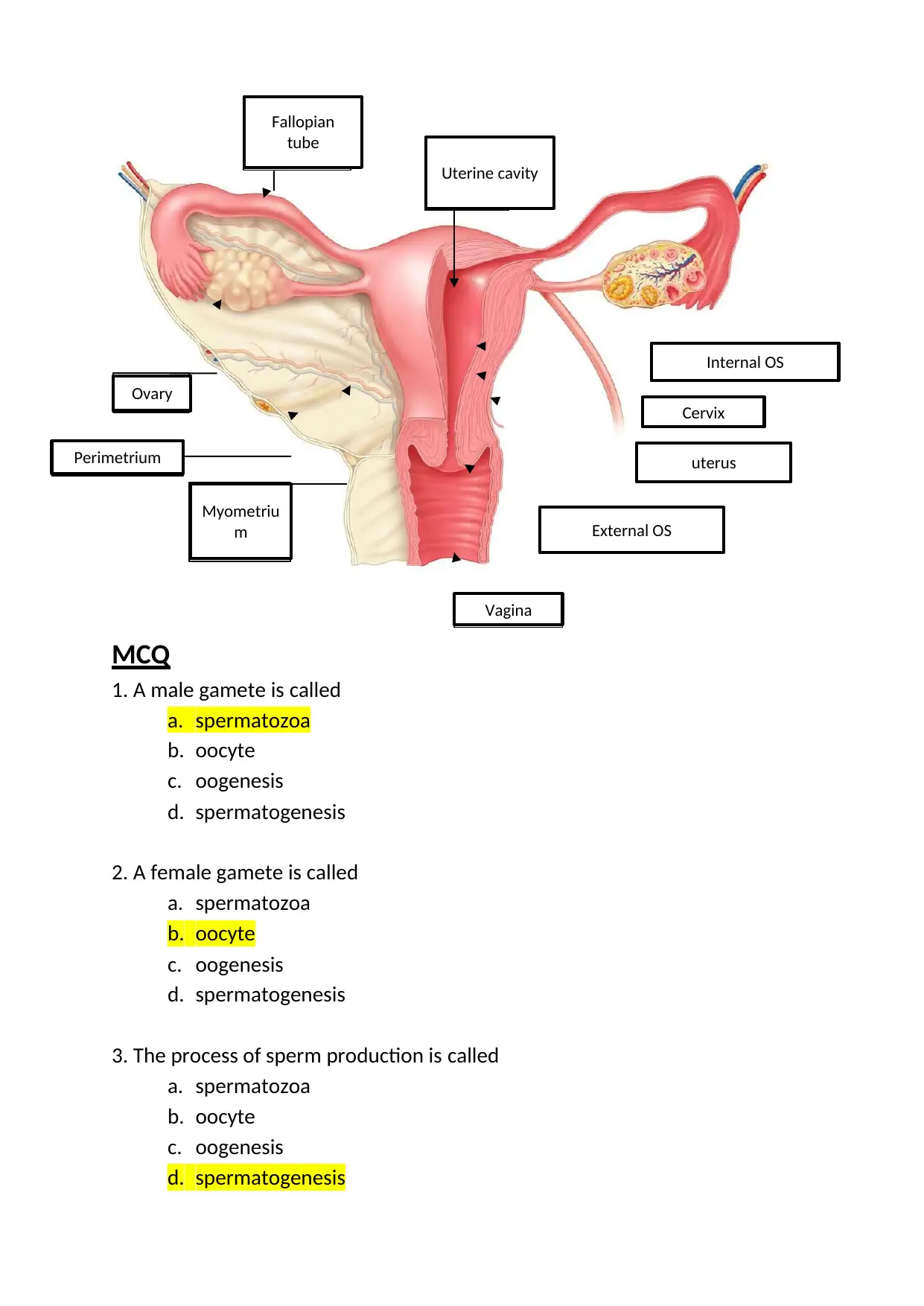
MCQ
1. A male gamete is called
a. spermatozoa
b. oocyte
c. oogenesis
d. spermatogenesis
2. A female gamete is called
a. spermatozoa
b. oocyte
c. oogenesis
d. spermatogenesis
3. The process of sperm production is called
a. spermatozoa
b. oocyte
c. oogenesis
d. spermatogenesis
Fallopian
tube
Uterine cavity
Ovary
Myometriu
m
Perimetrium
Vagina
External OS
Cervix
Internal OS
uterus
1. A male gamete is called
a. spermatozoa
b. oocyte
c. oogenesis
d. spermatogenesis
2. A female gamete is called
a. spermatozoa
b. oocyte
c. oogenesis
d. spermatogenesis
3. The process of sperm production is called
a. spermatozoa
b. oocyte
c. oogenesis
d. spermatogenesis
Fallopian
tube
Uterine cavity
Ovary
Myometriu
m
Perimetrium
Vagina
External OS
Cervix
Internal OS
uterus
⊘ This is a preview!⊘
Do you want full access?
Subscribe today to unlock all pages.

Trusted by 1+ million students worldwide
1 out of 67
Related Documents
Your All-in-One AI-Powered Toolkit for Academic Success.
+13062052269
info@desklib.com
Available 24*7 on WhatsApp / Email
![[object Object]](/_next/static/media/star-bottom.7253800d.svg)
Unlock your academic potential
Copyright © 2020–2025 A2Z Services. All Rights Reserved. Developed and managed by ZUCOL.





